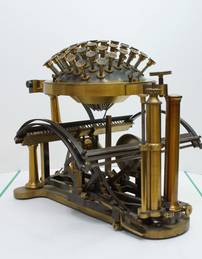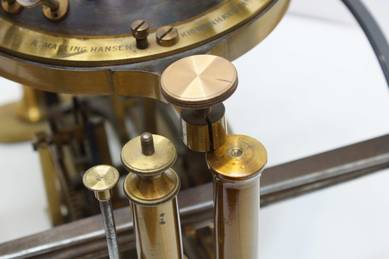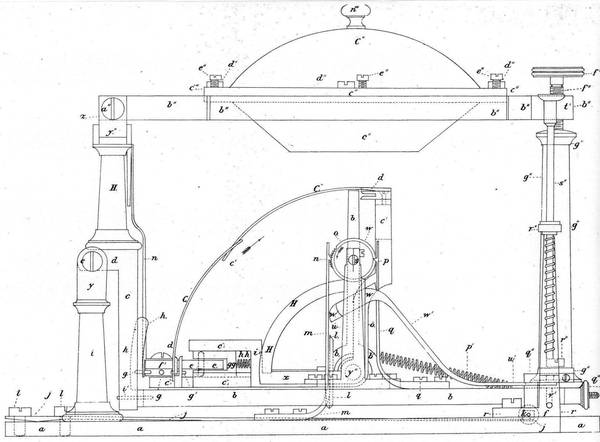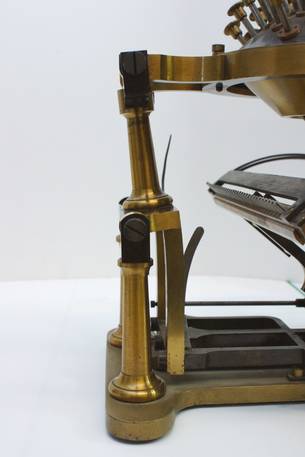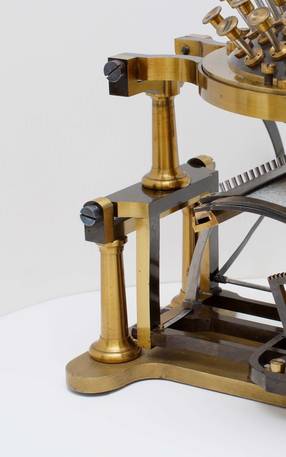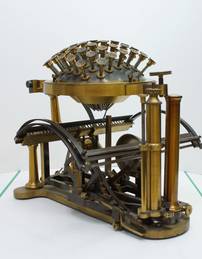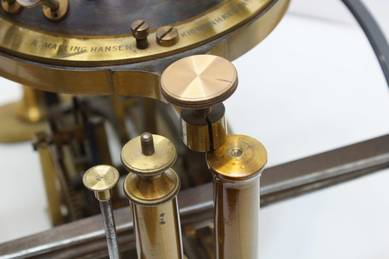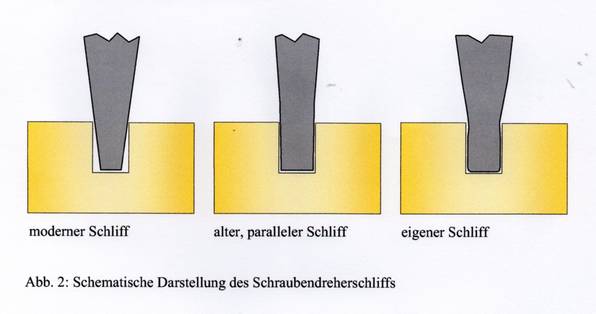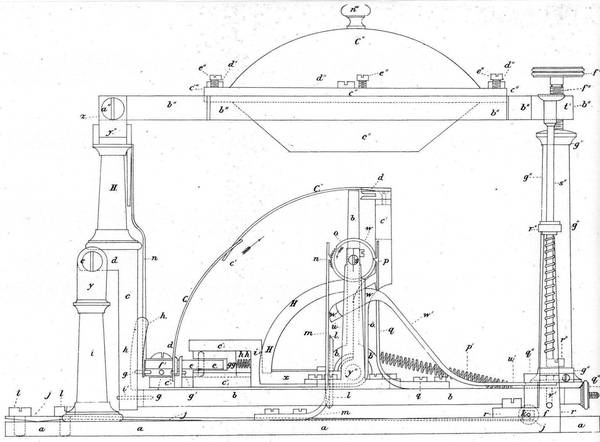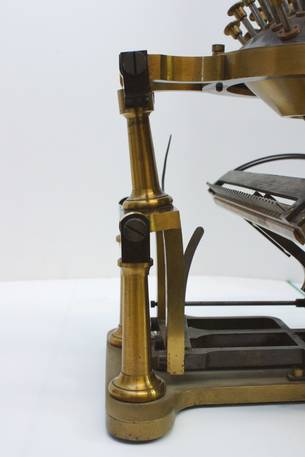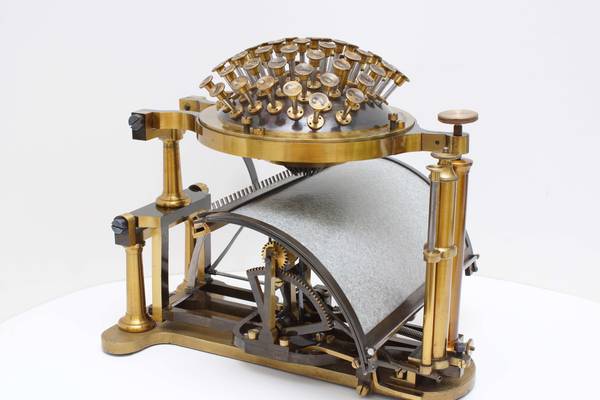Number 46 is alive!
By Dieter Eberwein
Translation from German to English by Jørgen Malling Christensen.
Already nine years have passed by since I came across this Malling-Hansen writing ball for the first time. On that occasion we were standing with some of the members of the recently founded International Rasmus Malling-Hansen Society in front of a table in the archives of the Danish Museum of Science and Technology in Helsingør, awed by the unexpected sight. In front of our eyes were writing balls of all the different models, from the 1870 “Box” model, a wooden box with the keyboard rising above and outside the box, to the electrically powered “large writing ball”, as well as the portable writing ball with automatic ink ribbon feeding mechanism from 1878 and later. The latter was offered with a variety of types, came in a beautiful mahogany box and was delivered to well-healed customers all over the world. However, probably less than 200 specimen of this technical wonder were ever sold, because this, the first serially produced typewriters in the world, first of all needed to create a commercial demand.
In professional circles there is much admiration and respect towards the Malling-Hansen writing ball because of its perfect construction and high degree of precision, and in collectors’ circles it is presented as a showpiece, and this is not only due to its rarity. Every well stocked technical museum desires to own such a writing ball in order to be able to place the mechanical embodiment of aesthetics and perfection in the centre of their building, proud to draw the attention of all eyes.
We were now standing in front of 9 writing balls, each one more beautiful than the other. Picked from their safeguarded coffer, awoken from a hundred-year long sleep, they showed themselves from their best side – until we saw one exception, writing ball no.46!
This writing ball had suffered strong deformations because of a fall and consequently was no longer functional. The entire upper part of the writing ball had been pushed back at least 1 cm, a gear cluster had been forced out of its hinges, the paper support bent and twisted in its axel. When I looked even closer, other damages emerged, and my restorer persona immediate started to hatch a detailed plan...
Now, 9 years later number 46 is in my workshop and is about to be mended and restored. It is a wonderful and exciting task, for nothing must go wrong, no screwdriver must slip, no screw slot must be bent, no surface must be impaired or damaged. When we are dealing with such unique items, there is no plan B.
Strictly speaking, one machine of a serially produced typewriter does not constitute a unique specimen. However, here we are very nearly dealing with a unique specimen, since there is only one more surviving item of its kind – of this light and portable writing ball, only weighing 4,77 kilos, without a ribbon mechanism – and this is a specimen in Deutschen Museum, Munich.
First of all I clear my working table and bring out only those screwdrivers and special tools which a precision instrument maker would use in 1876, the production year of this writing ball. Behind me are microscopes of various dimensions and capacities, measuring instruments from many different ages and also modern tools, which I will use as a last resort. The room is equably heated, and the humidity will remain stable from now on. I am wearing a red T-shirt with a beautiful, very large imprint of a writing ball. This was a present from Paul Bech from the United States, a direct descendent of the inventor of the writing ball, Malling-Hansen.
The queen of typewriters, the writing ball, is now in front of me and appears in the operation lights bleak and frail. I grip it, gloves on, and turn it in the light. Every scratch and dust speck is now visible. By the enlargement of my magnifying glass each and every detail is being brought out. The words of my old master precision instrument maker, who reduced everything to the most important aspects, are brought to mind: “the instrument maker needs light and good sense[1]. At any rate, the first part has been taken well care of by means of the light switch. But for the rest I can only rely on myself and hence proceed systematically and with great care. I watch the machine from all sides, make notes, take measurements and make a sketch of the bent part. Even the initially unimportant looking screw slit is fixed in its position, something that later proves to be very useful. Subsequently I take photos of all essential details from different angles and with different light sources. In some photos the surface of a machine part is illustrated very well, and in others the shiny lacquer comes out well in all its facets and possible signs of wear and tear.
In my workshop all is quiet. No noise whatsoever takes my attention away from the machine, thereby allowing no lax routine in my task. And then I dive into the past with my work, and start taking apart the first group of machine parts. Each screw is handled with the proper respect and carefully turned. The screwdriver must always fit exactly into the screw slit, lest the screw head might be left with damages. A modern screwdriver is, seen from the side, wedge-shaped, the reason being that this allows for the tool to be used with different sizes of screws. However, in so doing, unfortunately the screwdriver will only work on the upper part of the screw slit and will always leave a mark. In previous times, the screwdriver and the adjoining screws would always be tailor-made in the workshop. The sides of the screwdriver would be made to be parallel and would fit perfectly in the handmade screws. As a restorer, however, today I take it a step further and shape the parallel screwdriver edge somewhat from above, the effect being that they will only fit with the lower part of the screwdriver edge and in so doing will leave no mark behind under any circumstances.
At closer inspection it is clearly recognizable how the writing ball was put together and how many different tools were in involved in this work in the past. A writing ball that has not yet been touched will show the least amount of damages. The instrument makers of C.P. Jürgensen’s workshop in Copenhagen did not leave behind any tool marks. I find under the anvil even relatively new support plates and some traces of a few modern screw slits of modern screwdrivers. These are traces of recent attempts to ‘rescue’ the machine.
I carefully separate and analyse each and every part, take photos, sketch, and place each separate machine part element on a white paper in a multi-layered office archive. The parts are placed in there surrounded by each of all the adjacent parts and screws, with descriptions, numeric designations and arrows added, so that on next Monday no doubt can emerge.
It is a great joy to dissemble such a technical masterpiece. However, it is necessary to slow down one’s pace and work exceedingly slowly. Everything which looks trivial and normal is also underestimated, including the screws. This is where most mistakes are liable to be made. For instance, brass screws must not be turned with much force, lest the heads be cut or broken off. A very fine lubricating oil, minimally dispensed, and ample time, are essential. This I accomplish with an ancient brush, which has only three-four hairs left. Every act of loosening a tight screw results in a thundering applause, which, however, I cannot hear.
After two days the writing ball is lying in front of me, successfully taken apart. It takes more than 30 archive drawers to keep all parts and details from each other and in careful order. And we must even keep in mind that we are dealing with a very simple, portable writing ball without ink ribbon mechanism, for the typed text was in 1875 still hidden under a carbon paper. The revolutionary inked ribbon mechanism with automatic feeding device was introduced in 1878 and immediately allowed a partial visibility of the typed text.
The writing ball, systematically taken to pieces, can by now be carefully observed in all its details, assessed and photographed again. I start with the bent parts. In this connection are also included the half-round bows of the paper support and the base angle of the oscillating superstructure. Luckily, I am in possession of a yellowed patent drawing of this very writing ball in its original size from 1875. A copy of this drawing with all surface details and sectional views is in front of me on my magnetic board. With this I am able to compare each bent piece with the drawing and immediately find out the nature of the deformation. This realization is, just like a diagnosis, merely the first important step, which is to be followed by the considerably more complicated and difficult process of repair and restoration.
To repair pieces of brass and bend them back to their original position and shape requires profound knowledge of materials and substances, coupled with the utmost care. “Brass can only be bent once”, my master used to say. This brittle material is broken if bent back suddenly and jerkily, because a copper-zinc alloy has very bad tensile properties. For instance, when a brass tube is being bent, the interior jumps up in shapes like an accordion, whereby the exterior suffers a strain and even starts to whiten. When bending it back, the creases of the strained interior will break in the weak parts of their folds. This can only be avoided by heating the material to a temperature of around 350˚C and immediately thereafter bending it a maximum of 2˚. With Nietzsche’s writing ball I was able to successfully use this technique on the bent cover screw, which also had the function of space bar; however, when doing this, I had to take care that the lacquered top side of the screw was simultaneously being cooled down and must not become warmer than 80˚C.
However, with number 46 things are quite different. Here the twisted part is completely lacquered, something that definitely does not allow heating beyond 80˚C. The best way to resolve a problem is to get rid of it...
I start the actual restoration work by cleaning the numerous parts placed in front of me and hereafter keep them in immaculately clean conditions. The parts which are ready to be pieced together again I put back into a clean archive drawer with a new label. Each drawer is then covered with PE-film. This kind of task requires a lot of time, since there are severely corroded steel parts, where I have to remove the corrosion chemically. On my right hand side, under the table, is a waste container into which a used cotton swap falls every 20 to 30 seconds. Likewise I must change my gloves each time I have finished cleaning a part, so that the preservation process of the next part may begin.
The restoration of the helical spring, the screws, type bars and types requires other methods than the lacquered brass parts. Concerning the latter, what is needed is not so much protection against corrosion, rather it is much more a question of the correct lacquer protection for the next few decades. Each lacquered part is therefore – after cleaning – carefully covered with an invisible, non-greasy, protection, which under museum conditions will dissolve slowly and only in the course of one life-time. With the correct lacquer-protective cover the ageing process of the lacquer is slowed down and, hence, this will hamper the cracking.
Still I remained with two strongly bent lacquered parts, which could not simply be bent back since they, as already pointed out, would break. It was necessary to heat up the material and perform several bending operations, but this was unfortunately impossible because of the lacquered surfaces. To bend back lacquered brass parts without changing the lacquer is an enormous challenge, requiring everything I had and knew. I am going to soften the bent part softly “kneading” it and in so doing gradually take it back to its original shape. In this way the material is only moved and bent in a tiny area of elasticity, so that the structure is getting used to the change it is undergoing. After 30 to 40 elastic movements comes one bend amounting to at most 1˚ in the moulded area. In this way also the hitherto aged lacquer is able to go along without cracking. One has to be exceeding careful about this kind of lacquer. Therefore the vice jaws wear a firm, smooth piece of rubber, covered with a fine piece of silk, so that no imprint is left in the lacquer.
Unfortunately the base angle of the swinging upper part is bent 8,5˚, requiring patience and full concentration. With each final bending process spanning 1˚, the tension is heightened – fortunately only in me, not in the material. The eagerly awaited measuring results show after each bending process, if the expected result has come about.
This is followed by a surface observation under the microscope. I can see layer upon layer of the lacquer all the way to the metal and must draw the conclusion that there is a looming change coming on. Only when everything is in order, the next phase of the bending process may begin. Now I stop. The last degree allows itself to be bent back to the zero position only when one overstretches the material in the positive area. The base angle would for the first time experience this position and the lacquer would certainly crack. The risk that the base angle thereby also cracks would be far too high. With that done I finish – satisfied - the bending process, happy that so far everything has gone well. The fact that the base angle remains bent around 1˚, is no longer visible to the human eye and technically does not cause any change in the writing ball.
The feeling in connection with the reassembling the writing ball is hardly possible to describe in words. The anticipation about the finally restored writing ball predominates everything else. Around me everything is now free of dust and even my clothes are white. For this special occasion I put on a white T-shirt with a beautiful imprint of a writing ball, a gift from Jørgen Malling, direct descendent of Malling-Hansen. Then I start assembling the writing ball, an activity just like they did it 140 years ago. The hands are holding tools and are, themselves, tools. My thoughts are entirely focused on the writing ball, time and place merge and become increasingly unimportant. The individual pieces are added to the various machine parts, and the writing ball becomes ever more perfect with each part, until it stands before me, completed and no more screws left to add. Number 46 is completed! And now follows – just like any human birth - the slap in the behind: the actuation of a key. The machine then, after a brief moment, activates the feeder and leads the upper part purposefully back into the starting position. Number 46 is alive!
Dieter Eberwein, 2015
[1] JMC: Translator’s note: The German word in the original text: ‘Verstand’ is broader that the English equivalent; it can also be understood as ‘mind’, ‘intellect’, ‘intelligence’, ‘brains’, ‘reason’, depending on the context.
Nummer 46 lebt!
Seit meiner letzten Begegnung mit dieser Malling-Hansen Schreibkugel sind nun schon 9 Jahre vergangen. Wir standen damals mit einigen Mitgliedern der neu gegründeten Malling-Hansen Gesellschaft vor einem Tisch im Archiv des Dänischen Technikmuseums in Helsingør und waren überwältigt von dem unerwarteten Anblick. Vor unseren Augen zeigten sich Schreibkugeln aller Modellreihen, begonnen bei der 1870 vorgestellten „Box“, einem Holzkasten mit außen liegender Tastatur, über die elektrisch betriebene „große Schreibkugel“, bis hin zu den portablen Schreibkugeln mit automatischem Farbbandvorschub aus den Jahren 1878 und später. Letztere wurden mit verschiedenen Schriftzeichen angeboten und in einem schönen Mahagoni-Holzkoffer an die gut betuchten Kunden in aller Welt ausgeliefert.
Allerdings wurden von diesem technischen Wunderwerk, wohl weniger als 200 Stück verkauft, weil diese erste in Serie hergestellte Schreibmaschine der Welt sich zunächst noch einen Markt schaffen musste.
In Fachkreisen wird die Malling-Hansen Schreibkugel wegen ihrer Präzision und perfekten Konstruktion mit Bewunderung und Respekt aufgenommen und in Sammlerkreisen nicht nur aufgrund ihrer Seltenheit als Glanzstück präsentiert. Jedes gut bestückte Technikmuseum, strebt nach so einer Schreibkugel, um sie als die mechanische Verkörperung von Ästhetik und Perfektion in der Mitte des Hauses zu platzieren, um mit Stolz alle Blicke auf sie zu lenken.
Wir standen nun vor 9 Schreibkugeln, eine schöner als die andere. Herausgeholt aus einem Safe, erweckt aus einem hundertjährigen Schlaf, präsentierten sie sich von ihrer besten Seite – bis auf eine Schreibkugel, die Nummer 46!
Diese Schreibkugel hatte starke Deformationen in Folge eines Sturzes erfahren und war daher nicht mehr funktionsfähig. Der gesamte Oberbau der Schreibkugel war um über 1 cm nach hinten versetzt, ein Zahnradblock aus den Angeln gehoben, der Papierträger verbogen und in seiner Achse verdreht. Weitere Schäden zeigten sich bei genauem Hinsehen, so dass der Restaurator in mir mit einem genauen Plan startete….
Jetzt, 9 Jahre später steht die Nummer 46 in meiner Restaurationswerkstatt und will kuriert werden. Es ist eine schöne und spannende Aufgabe zugleich, denn nichts darf schief gehen, kein Schraubendreher ausrutschen, kein Schraubenschlitz verbiegen und keine Oberfläche beeinträchtigt oder beschädigt werden. Es gibt bei solchen Unikaten keinen Plan B.
Genau genommen ist eine in Serie hergestellte Schreibmaschine kein Unikat. Aber hier handelt es sich nahezu um ein Unikat, denn es gibt von ihrer Art, von genau diesem nur 4,77 kg leichten, portablen Modell ohne Farbbandmechanismus, nur noch eine weitere überlebende Schreibkugel im Deutschen Museum in München.
Als erstes räume ich meinen Tisch komplett frei und lege nur noch jene Schraubendreher und Spezialwerkzeuge zurecht, die ein Feinmechaniker im Jahre 1876, im Erstellungsjahr dieser Schreibkugel, verwenden konnte. Hinter mir befinden sich Mikroskope verschiedener Größenklassen, Messinstrumente aus allen Epochen und auch moderne Werkzeuge, die ich nur im Notfall hinzuziehen will. Der Raum ist gleichmäßig temperiert und die Luftfeuchtigkeit wird ab jetzt nicht mehr schwanken. Ich trage ein rotes T-Shirt mit einem schönen, riesigen Schreibkugel-Aufdruck. Es war ein Geschenk von Paul Bech aus den USA, einem direkten Nachfahren des Schreibmaschinen-Erfinders Malling-Hansen.
Die Königin der Schreibmaschinen, die Schreibkugel, steht jetzt vor mir und erscheint bei eingeschalteter OP-Beleuchtung blass und krank. Ich fasse sie mit meinen Handschuhen an und drehe sie weiter ins Licht. Jeder Kratzer und jedes Staubkorn wird nun sichtbar. Durch die Vergrößerung meiner Lupen bleibt kein Detail mehr verborgen. Ich denke an dieser Stelle an meinen alten Feinmechaniker-Meister, der alles auf das Wesentliche reduzierte. „Der Feinmechaniker braucht Licht und Verstand“. Den ersten Teil habe ich jedenfalls durch Betätigung der Schalter schnell erledigt. Ab hier kann ich mich nur noch auf mich selbst verlassen und gehe daher systematisch vor. Ich betrachte die Maschine von allen Seiten, mache mir Notizen, vermesse und skizziere die Lage der verbogenen Bauteile. Selbst jeder zunächst unwichtig erscheinende Schraubenschlitz wird in seiner Ausrichtung festgehalten, was später von großem Nutzen sein wird. Ich fotografiere dann alle wesentlichen Details aus verschiedenen Richtungen und mit verschiedenen Lichtquellen. Auf dem einen Foto zeigt sich die ebene Fläche eines Bauteils sehr gut, und auf einem anderen Foto zeigt sich der spiegelnde Lack in all seinen Facetten und eventuellen Abnutzungen.
In meiner Restaurationswerkstatt herrscht jetzt Stille. Kein Geräusch lenkt mich von der Maschine ab, damit keine Routine aufkommt. Und dann tauche ich mit meinen Arbeiten in die Vergangenheit ein und beginne mit dem Zerlegen der ersten Baugruppen. Jede Schraube wird dabei mit gehörigem Respekt angefasst und vorsichtig gedreht. Der Schraubendreher muss dabei immer genau zu dem Schraubenschlitz passen, da sonst Beschädigungen am Schraubenkopf hinterlassen werden. Ein moderner Schraubendreher ist von der Seite gesehen keilförmig, damit er für verschiedene Schraubengrößen eingesetzt werden kann. Er wirkt daher mit seiner Kraft leider nur an der oberen Kante des Schraubenschlitzes und hinterlässt immer Abdrücke. Früher wurden die Schraubendreher und auch die Schrauben in jeder Werkstatt auf Maß angefertigt. Die Flanken der Schraubendreher waren daher parallel und passten sehr gut in die selbst geschlitzten Schrauben. Als Restaurator gehe ich heute aber noch ein Stück weiter und verjünge die parallel geschliffenen Schraubendreher nach oben hin etwas, damit sie nur im untersten Bereich des Schraubenschlitzes ansetzen können und somit auf keinen Fall Spuren hinterlassen können.
Illustration 3: Patency drawing 1875 London, the D. Eberwein archive
To repair pieces of brass and bend them back to their original position and shape requires profound knowledge of materials and substances, coupled with the utmost care. “Brass can only be bent once”, my master used to say. This brittle material is broken if bent back suddenly and jerkily, because a copper-zinc alloy has very bad tensile properties. For instance, when a brass tube is being bent, the interior jumps up in shapes like an accordion, whereby the exterior suffers a strain and even starts to whiten. When bending it back, the creases of the strained interior will break in the weak parts of their folds. This can only be avoided by heating the material to a temperature of around 350˚C and immediately thereafter bending it a maximum of 2˚. With Nietzsche’s writing ball I was able to successfully use this technique on the bent cover screw, which also had the function of space bar; however, when doing this, I had to take care that the lacquered top side of the screw was simultaneously being cooled down and must not become warmer than 80˚C.
However, with number 46 things are quite different. Here the twisted part is completely lacquered, something that definitely does not allow heating beyond 80˚C. The best way to resolve a problem is to get rid of it...
I start the actual restoration work by cleaning the numerous parts placed in front of me and hereafter keep them in immaculately clean conditions. The parts which are ready to be pieced together again I put back into a clean archive drawer with a new label. Each drawer is then covered with PE-film. This kind of task requires a lot of time, since there are severely corroded steel parts, where I have to remove the corrosion chemically. On my right hand side, under the table, is a waste container into which a used cotton swap falls every 20 to 30 seconds. Likewise I must change my gloves each time I have finished cleaning a part, so that the preservation process of the next part may begin.
The restoration of the helical spring, the screws, type bars and types requires other methods than the lacquered brass parts. Concerning the latter, what is needed is not so much protection against corrosion, rather it is much more a question of the correct lacquer protection for the next few decades. Each lacquered part is therefore – after cleaning – carefully covered with an invisible, non-greasy, protection, which under museum conditions will dissolve slowly and only in the course of one life-time. With the correct lacquer-protective cover the ageing process of the lacquer is slowed down and, hence, this will hamper the cracking.
Still I remained with two strongly bent lacquered parts, which could not simply be bent back since they, as already pointed out, would break. It was necessary to heat up the material and perform several bending operations, but this was unfortunately impossible because of the lacquered surfaces. To bend back lacquered brass parts without changing the lacquer is an enormous challenge, requiring everything I had and knew. I am going to soften the bent part softly “kneading” it and in so doing gradually take it back to its original shape. In this way the material is only moved and bent in a tiny area of elasticity, so that the structure is getting used to the change it is undergoing. After 30 to 40 elastic movements comes one bend amounting to at most 1˚ in the moulded area. In this way also the hitherto aged lacquer is able to go along without cracking. One has to be exceeding careful about this kind of lacquer. Therefore the vice jaws wear a firm, smooth piece of rubber, covered with a fine piece of silk, so that no imprint is left in the lacquer.
Unfortunately the base angle of the swinging upper part is bent 8,5˚, requiring patience and full concentration. With each final bending process spanning 1˚, the tension is heightened – fortunately only in me, not in the material. The eagerly awaited measuring results show after each bending process, if the expected result has come about.
This is followed by a surface observation under the microscope. I can see layer upon layer of the lacquer all the way to the metal and must draw the conclusion that there is a looming change coming on. Only when everything is in order, the next phase of the bending process may begin. Now I stop. The last degree allows itself to be bent back to the zero position only when one overstretches the material in the positive area. The base angle would for the first time experience this position and the lacquer would certainly crack. The risk that the base angle thereby also cracks would be far too high. With that done I finish – satisfied - the bending process, happy that so far everything has gone well. The fact that the base angle remains bent around 1˚, is no longer visible to the human eye and technically does not cause any change in the writing ball.
Illustration 4: Base angle of the swinging upper structure (to the left bent/to the right restored)
The feeling in connection with the reassembling the writing ball is hardly possible to describe in words. The anticipation about the finally restored writing ball predominates everything else. Around me everything is now free of dust and even my clothes are white. For this special occasion I put on a white T-shirt with a beautiful imprint of a writing ball, a gift from Jørgen Malling, direct descendent of Malling-Hansen. Then I start assembling the writing ball, an activity just like they did it 140 years ago. The hands are holding tools and are, themselves, tools. My thoughts are entirely focused on the writing ball, time and place merge and become increasingly unimportant. The individual pieces are added to the various machine parts, and the writing ball becomes ever more perfect with each part, until it stands before me, completed and no more screws left to add. Number 46 is completed! And now follows – just like any human birth - the slap in the behind: the actuation of a key. The machine then, after a brief moment, activates the feeder and leads the upper part purposefully back into the starting position. Number 46 is alive!
Dieter Eberwein, 2015
Illustration 5: The completely restored writing ball no. 46
[1] JMC: Translator’s note: The German word in the original text: ‘Verstand’ is broader that the English equivalent; it can also be understood as ‘mind’, ‘intellect’, ‘intelligence’, ‘brains’, ‘reason’, depending on the context.
Bei näherer Betrachtung kann man genau erkennen wie die Schreibkugel montiert wurde, mit wie vielen unterschiedlichen Werkzeugen in der Vergangenheit gearbeitet wurde. Eine noch unangetastete Schreibkugel zeigt dabei die geringsten Beschädigungen. Die Feinmechaniker der Werkstatt von C. P. Jürgensen in Kopenhagen hinterließen kaum Werkzeugabdrücke. Ich erkenne unter dem Amboss sogar relativ neue Unterlegscheiben und diverse Spuren an einigen Schraubenschlitzen von modernen Schraubendrehern. Hier hat man in neuerer Zeit versucht, die Maschine zu retten.
Ich zerlege behutsam Teil für Teil, fotografiere, skizziere und lege jede zerlegte Baugruppe auf ein weißes Blatt Papier in eine stapelbare Büroablage. Die Teile liegen darin von allen Anbauten und Schrauben explosionsartig umgeben, mit Beschriftungen, Zahlenkombinationen und Pfeilen versehen, so dass bei der späteren Montage keine Fragen aufkommen können.
Es macht Spaß, so ein Meisterwerk der Technik zu zerlegen. Doch muss man sich dabei selbst bremsen und äußerst langsam arbeiten. Alles was trivial aussieht wird unterschätzt, so auch das Schrauben. Hie kann man das Meiste falsch machen. Festsitzende Messing-Schrauben z. B. dürfen nicht mit erhöhter Kraft gedreht werden, da sonst die Köpfe abscheren. Ein sehr feines Kriechöl in minimaler Dosierung und etwas Zeit sind hier vonnöten. Dies bewerkstellige ich mit einem alten Pinsel, der nur noch aus drei oder vier Borsten besteht.
Jedes Lösen einer festsitzenden Schraube führt zu einem tosenden Applaus, den wohl nur ich hören kann. Nach zwei Tagen liegt die Schreibkugel erfolgreich zerlegt vor mir. Es sind über 30 Ablagekästen nötig, um alle Einzelteile sorgfältig auseinander zu halten. Und dabei handelt es sich hier noch um eine sehr schlichte, portable Schreibkugel ohne einen Farbbandmechanismus, denn das Geschriebene blieb in den Jahren um 1875 noch unter einem Kohlepapier verborgen. Der revolutionäre Farbbandmechanismus mit automatischem Vorschub kam ab dem Jahre 1878 hinzu und führte bereits zu einer bedingten Sichtbarkeit des Geschriebenen.
Die systematisch zerlegte Schreibkugel lässt sich nun in allen Einzelteilen begutachten, bewerten und erneut fotografieren. Die verbogenen Teile gehe ich zuerst an. Hierzu zählen die halbrunden Bögen des Papierträgers und der Basiswinkel des schwingenden Oberbaus.
Glücklicherweise besitze ich eine mittlerweile vergilbte Patentzeichnung dieser Schreibkugel in Originalgröße aus dem Jahre 1875. Eine Kopie dieser Zeichnung mit allen Detailansichten und Schnittdarstellungen befindet sich vor mir an meiner Magnetwand. Ich kann somit jedes verbogene Teil auf seine Zeichnung halten und sofort die Deformation erkennen. Diese Erkenntnis ist wie eine gute Diagnose nur ein erster wichtiger Schritt, dem der viel aufwändigere und schwierigere Reparatur- und Restaurationsprozess folgt.
Verbogene Messingteile zu richten und in ihre Ausgangsposition zurück zu biegen, bedarf einer sehr guten Kenntnis des Materials, der Materie und einer besonderen Vorsicht. „Messing biegt man nur einmal“, war der Spruch meines Meisters. Dieses spröde Material bricht beim Zurückbiegen unvermittelt und ruckartig ab, weil eine Kupfer-Zink-Legierung sehr schlechte Zugeigenschaften hat. Beim Biegen eines Messingrohrs z. B. staucht sich der Innenbereich wie eine Ziehharmonika zusammen wobei der Außenbereich eine Dehnung erfährt und sogar weiß anläuft. Beim Zurückbiegen reißt der gestauchte Innenbereich an den Stauchfalten unvermittelt ab. Dies kann nur durch Erwärmen des Materials auf ca. 350 °C und anschließendes Biegen um maximal 2° vermieden werden. Bei Nietzsches Schreibkugel konnte ich diese Technik an der verbogenen Deckelschraube, die gleichzeitig als Leertaste funktionierte, erfolgreich anwenden, wobei die lackierte Oberseite der Schraube durch eine gleichzeitige Kühlung nicht wärmer als 80°C werden durfte.
Bei der Nummer 46 ist aber einiges anders. Hier sind die verbogenen Teile komplett lackiert, was eine Erwärmung auf über 80°C definitiv nicht zulässt. Ein Problem löst man am Besten indem man sich von dem Problem löst … Ich beginne mit der Reinigung also der eigentlichen Restauration der vor mir zahlreichliegenden Einzelteile und konserviere sie anschließend noch im saubersten Zustand. Die montierfertigen Einzelteile lege ich in eine saubere und neu beschriftete Ablage zurück. Jede Ablage wird anschließend mit einer PE-Folie abgedeckt. Diese Arbeiten nehmen viel Zeit inAnspruch, da es sehr stark korrodierte Stahlteile gibt, deren Rost rein chemisch entfernt werden muss. Rechts neben meinem Tisch steht ein Abfallbehälter in den alle 20 bis 30 Sekunden ein verbrauchtes Wattestäbchen fällt. Meine Handschuhe muss ich ebenso nach jedem gereinigten Teil tauschen, damit ich mit der Konservierung des nächsten Teils beginnen kann.
Die Restauration der Spiralfedern, Schrauben, Typenstangen und Typen erfordert andere Mittel als die lackierten Messingteile. Bei den letzteren geht es weniger um eine Korrosions-Bekämpfung sondern vielmehr um den richtigen Lackschutz für die kommenden Jahrzehnte. Jedes lackierte Teil wird daher behutsam nach seiner Reinigung mit einem unsichtbaren, nicht fettenden Lackschutz versehen, der sich unter Museumsbedingungen erst im Laufe eines Menschenlebens langsam auflösen wird. Mit dem richtigen Lackschutz wird die Alterung der Lackierung verlangsamt und damit die Rissbildung gehemmt.
Da waren aber noch zwei stark verbogene lackierte Teile, die man nicht einfach zurück biegen kann, weil sie, wie schon gesagt, brechen würden. Ein Erwärmen des Materials und mehrere Biegevorgänge wären zwar nötig, sind wegen der lackierten Flächen leider unmöglich.
Lackierte Messingteile zurück zu biegen ohne den Lack zu verändern, ist eine riesige Herausforderung, die mir Alles abverlangt. Ich will die verbogenen Teile daher „weichkneten“ und anschließend nach und nach in die richtige Form zurückführen. Das Material wird dabei nur im sehr geringen elastischen Bereich hin und her gebogen, damit sich das Gefüge an die Veränderung gewöhnt. Nach ca. 30 bis 40 elastischen Bewegungen erfolgt eine Biegung um höchstens 1° in den plastischen Bereich. Auf diese Weise kann auch der mittlerweile gealterte Lack mitgehen ohne zu reißen. Auf diesen Lack muss man besonders aufpassen. Daher sind die Schraubstockbacken mit einem festen, glatten Gummi versehen und mit einem feinen Seidenstoff überzogen, damit keine Abdrücke in dem Lack entstehen.
Der Basiswinkel des schwingenden Oberbaus ist leider um 8,5° verbogen und erfordert Geduld und volle Konzentration. Mit jedem abschließenden Biegevorgang um 1° erhöht sich die Spannung - zum Glück nur bei mir und nicht bei dem Material. Die heiß ersehnten Messvorgänge zeigen nach jedem Biegevorgang, ob das erwartete Ergebnis eingetroffen ist.
Danach erfolgt eine Betrachtung der Oberfläche unter dem Mikroskop. Man kann dabei den Klarlack Schicht für Schicht bis auf den Grund betrachten und muss eine sich anbahnende Veränderung im Keim erkennen. Nur wenn alles in Ordnung ist, kann der nächste Biegevorgang gestartet werden. Mit jedem weiteren Grad steigt die Spannung, bis ca. 7,5° erfolgreich zurück gebogen wurden. Jetzt halte ich Inne. Das letzte Grad lässt sich nur dann auf das Null-Maß zurück biegen, wenn man das Material in den positiven Bereich überstreckt.
Diese Position würde der Basiswinkel zum ersten Mal erfahren und der Lack würde sicher reißen. Das Risiko, dass der Basiswinkel dabei ebenso bricht wäre viel zu hoch. Somit beende ich zufrieden die Biegevorgänge und freue mich, dass bisher alles gut gegangen ist. Dass der Basiswinkel noch um ca. 1° gebogen ist, fällt optisch nicht mehr auf und führt technisch zu keiner Veränderung der Schreibkugel.
Das Gefühl bei der Montage der Schreibkugel lässt sich in Worten kaum ausdrücken. Die Vorfreude auf die fertig restaurierte Schreibkugel überwiegt alles. Um mich herum ist jetzt alles staubfrei und sauber und sogar meine Kleidung ist weiß. Für diesen besonderen Anlass greife ich auf ein weißes T-Shirt mit einem schönen Schreibkugelaufdruck zurück, einem Geschenk von Jørgen Malling, einem direkten Nachfahren von Malling-Hansen.
Dann beginne ich mit der Montage der Schreibkugel, einer Tätigkeit wie vor 140 Jahren. Die Hände halten Werkzeuge und sind Werkzeug zugleich. Die Gedanken drehen sich nur noch um die Schreibkugel, so dass Raum und Zeit verschmelzen und zunehmend unwichtig werden.
Die Einzelteile fügen sich zu Baugruppen und die Schreibkugel wird mit jedem Teil vollkommener, bis sie fertig vor mir steht und keine Schraube mehr zu setzen ist. Die Nummer 46 ist fertig! Und jetzt kommt wie bei jeder menschlichen Geburt der Klaps auf den Hintern - die Betätigung einer Taste. Die Maschine startet daraufhin mit einem kurzen Ticken die Auslösung des Zeichenvorschubs und federt den Oberbau zielgerichtet in die Ausgangsstellung zurück. Die Nummer 46 lebt!
Dieter Eberwein, 2015

